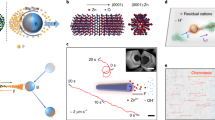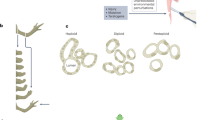Abstract
Artificial cell mimicry is extremely valuable in basic and applied biotechnological research. However, the existing construction of artificial cell compartments is typically static, creating a distinction between them and the dynamic natural cells. Herein, we describe a programmable dynamic artificial cell model using swarm nanorobotics and cell-free synthetic transcription-translation solution chemistry. Under the physical control of two- or three-dimensional magnetic fields by varying the direction, strength, and frequency, diverse compartmentation configurations in clusters, chains, and sheets were produced with DNAs and magnetic particles of different morphologies. These diverse dynamic artificial cell architectures exhibit distinct transcription and translation activities. Using swarm robotics and synthetic life chemistry could provide a new paradigm to construct imaginative artificial cells and provide significant insights into the fundamental life processes and biological applications.
摘要
人工细胞构筑在基础和应用生物技术研究中具有重要意义. 然 而, 现有的人工细胞区室化的构建往往是静态的, 与动态的自然细胞存 在差距. 基于此, 我们通过前沿磁控纳米机器技术和无细胞转录-翻译 溶液化学系统来构筑一个可编程控制的动态人工细胞. 通过物理控制 二维或三维磁场的方向、强度和频率, 基于不同形态的DNA和磁性颗 粒产生不同形貌的簇、链和片等区室化排列. 这些不同形貌的动态人 工细胞结构呈现出特殊的转录-翻译性能. 集群机器人技术和合成生命 化学的融合利用可为构筑富有想象力的人工细胞提供新的研究范式, 并为生命过程的理解和颠覆性的生物应用提供重要支撑.

Similar content being viewed by others
References
Ding Y, Wu F, Tan C. Synthetic biology: A bridge between artificial and natural cells. Life, 2014, 4: 1092–1116
Noireaux V, Maeda YT, Libchaber A. Development of an artificial cell, from self-organization to computation and self-reproduction. Proc Natl Acad Sci USA, 2011, 108: 3473–3480
Zhang Y, Ruder WC, LeDuc PR. Artificial cells: Building bioinspired systems using small-scale biology. Trends Biotechnol, 2008, 26: 14–20
Xu C, Hu S, Chen X. Artificial cells: From basic science to applications. Mater Today, 2016, 19: 516–532
Luisi PL, Walde P, Oberholzer T. Lipid vesicles as possible intermediates in the origin of life. Curr Opin Colloid Interface Sci, 1999, 4: 33–39
Yang D, Peng S, Hartman MR, et al. Enhanced transcription and translation in clay hydrogel and implications for early life evolution. Sci Rep, 2013, 3: 3165
Thavarajah W, Silverman AD, Verosloff MS, et al. Point-of-use detection of environmental fluoride via a cell-free riboswitch-based biosensor. ACS Synth Biol, 2020, 9: 10–18
Jung JK, Alam KK, Verosloff MS, et al. Cell-free biosensors for rapid detection of water contaminants. Nat Biotechnol, 2020, 38: 1451–1459
Prakash S, Jones ML. Artificial cell therapy: New strategies for the therapeutic delivery of live bacteria. J Biomed Biotechnol, 2005, 2005(1): 44–56
Elani Y, Law RV, Ces O. Protein synthesis in artificial cells: Using compartmentalisation for spatial organisation in vesicle bioreactors. Phys Chem Chem Phys, 2015, 17: 15534–15537
Gabaldón T, Pittis AA. Origin and evolution of metabolic sub-cellular compartmentalization in eukaryotes. Biochimie, 2015, 119: 262–268
Uversky VN. Intrinsically disordered proteins in overcrowded milieu: Membrane-less organelles, phase separation, and intrinsic disorder. Curr Opin Struct Biol, 2017, 44: 18–30
Elani Y, Law RV, Ces O. Vesicle-based artificial cells as chemical microreactors with spatially segregated reaction pathways. Nat Commun, 2014, 5: 5305
Hindley JW, Zheleva DG, Elani Y, et al. Building a synthetic mechanosensitive signaling pathway in compartmentalized artificial cells. Proc Natl Acad Sci USA, 2019, 116: 16711–16716
Brea RJ, Hardy MD, Devaraj NK. Towards self-assembled hybrid artificial cells: Novel bottom-up approaches to functional synthetic membranes. Chem Eur J, 2015, 21: 12564–12570
Kojima T, Takayama S. Membraneless compartmentalization facilitates enzymatic cascade reactions and reduces substrate inhibition. ACS Appl Mater Interfaces, 2018, 10: 32782–32791
Lai SN, Zhou X, Ouyang X, et al. Artificial cells capable of long-lived protein synthesis by using aptamer grafted polymer hydrogel. ACS Synth Biol, 2020, 9: 76–83
Park N, Um SH, Funabashi H, et al. A cell-free protein-producing gel. Nat Mater, 2009, 8: 432–437
Zubaite G, Hindley JW, Ces O, et al. Dynamic reconfiguration of subcompartment architectures in artificial cells. ACS Nano, 2022, 16: 9389–9400
Phair RD, Misteli T. High mobility of proteins in the mammalian cell nucleus. Nature, 2000, 404: 604–609
Yang L, Zhang L. Motion control in magnetic microrobotics: From individual and multiple robots to swarms. Annu Rev Control Robot Auton Syst, 2021, 4: 509–534
Katz E, Lioubashevski O, Willner I. Magnetic field effects on cytochrome c-mediated bioelectrocatalytic transformations. J Am Chem Soc, 2004, 126: 11088–11092
Nirenberg MW, Matthaei JH. The dependence of cell-free protein synthesis in E. coli upon naturally occurring or synthetic polyribonucleotides. Proc Natl Acad Sci USA, 1961, 47: 1588–1602
Lu Y. Cell-free synthetic biology: Engineering in an open world. Synth Syst Biotechnol, 2017, 2: 23–27
Liu D, Li S, Zhang T, et al. 3D magnetic field-controlled synthesis, collective motion, and bioreaction enhancement of multifunctional peasecod-like nanochains. ACS Appl Mater Interfaces, 2021, 13: 36157–36170
Wang H, Zhao Z, Liu Y, et al. Biomimetic enzyme cascade reaction system in microfluidic electrospray microcapsules. Sci Adv, 2018, 4: eaat2816
Zhang X, Chen G, Fu X, et al. Magneto-responsive microneedle robots for intestinal macromolecule delivery. Adv Mater, 2021, 33: 2104932
Acknowledgements
This work was supported by the National Natural Science Foundation of China (21878173 and 22278241), the National Key R&D Program of China (2018YFA0901700), a grant from the Institute Guo Qiang, Tsinghua University (2021GQG1016), and the Department of Chemical Engineering-iBHE Joint Cooperation Fund.
Author information
Authors and Affiliations
Contributions
The manuscript was written through contributions of all authors. All authors have given approval to the final version of the manuscript. Cheng X, Wang C, and Liu D performed the experiments and wrote the paper. Liao Y and Wang B contributed to the theoretical analysis. Zhang X, Zheng H, and Lu Y designed the research. Lu Y revised the paper.
Corresponding author
Additional information
Conflict of interest
The authors declare that they have no conflict of interest.
Supplementary information
Experimental details and supporting data are available in the online version of the paper.
Xiaowen Cheng received her BS degree (2021) in food science and engineering from Beijing Forestry University. She is currently a graduate student at the School of Food Science and Nutritional Engineering, China Agricultural University. She joined Lu’s group at Tsinghua University in 2021. Her research interest is to build dynamic artificial cells using nanorobots.
Chen Wang received his BS degree (2019) in chemical engineering and industrial bioengineering from Tsinghua University, China. He is now a PhD candidate at the Institute of Biochemical Engineering, Department of Chemical Engineering, Tsinghua University. His main research subject is constructing nucleic acid delivery systems based on the concept of artificial cells.
Dong Liu received the BS degree (2018) in chemical engineering and industrial bioengineering from Tsinghua University, China. Then, as a PhD candidate, he joined the Institute of Biochemical Engineering at the Department of Chemical Engineering, Tsinghua University. His research interest includes the development of medical biohybrid microrobots for active therapeutics and their hydrodynamics, smart materials and flexible electronics, and the bench-to-bedside translational analysis of advanced therapeutics.
Yuan Lu received his BS (2004) and PhD (2009) degrees in chemical engineering from Tsinghua University, China. Then he received postdoctoral training from Johns Hopkins University (2009–2010) and Stanford University (2010–2014), USA. He was a project researcher at the University of Tokyo, Japan from 2014 to 2016. In 2016, Dr. Lu joined the faculty of Chemical Engineering at Tsinghua University, China. The central paradigm of Yuan Lu’s research is using interdisciplinary approaches to engineer molecules and systems in multi-scale for addressing the most daunting challenges in human health.
Electronic Supplementary Material
Rights and permissions
About this article
Cite this article
Cheng, X., Wang, C., Liu, D. et al. Dynamic artificial cells by swarm nanorobotics and synthetic life chemistry. Sci. China Mater. 66, 2090–2099 (2023). https://doi.org/10.1007/s40843-022-2305-1
Received:
Accepted:
Published:
Issue Date:
DOI: https://doi.org/10.1007/s40843-022-2305-1




